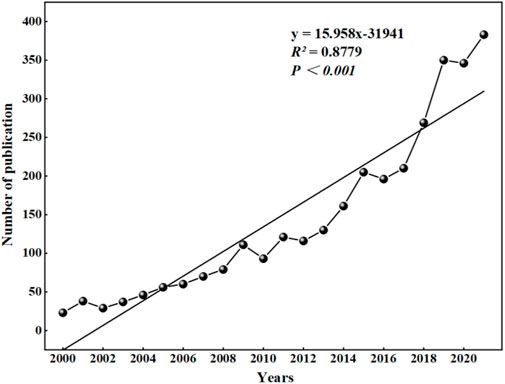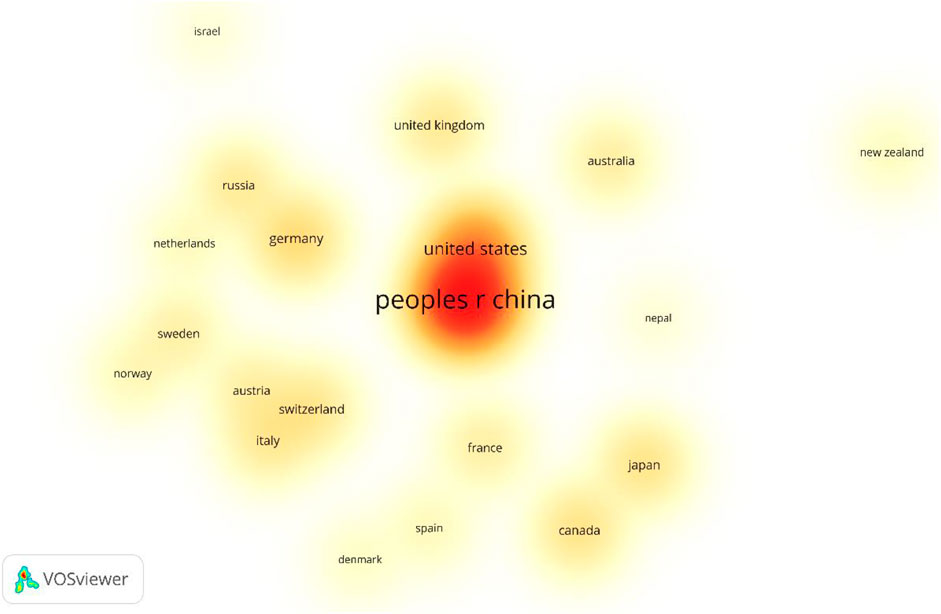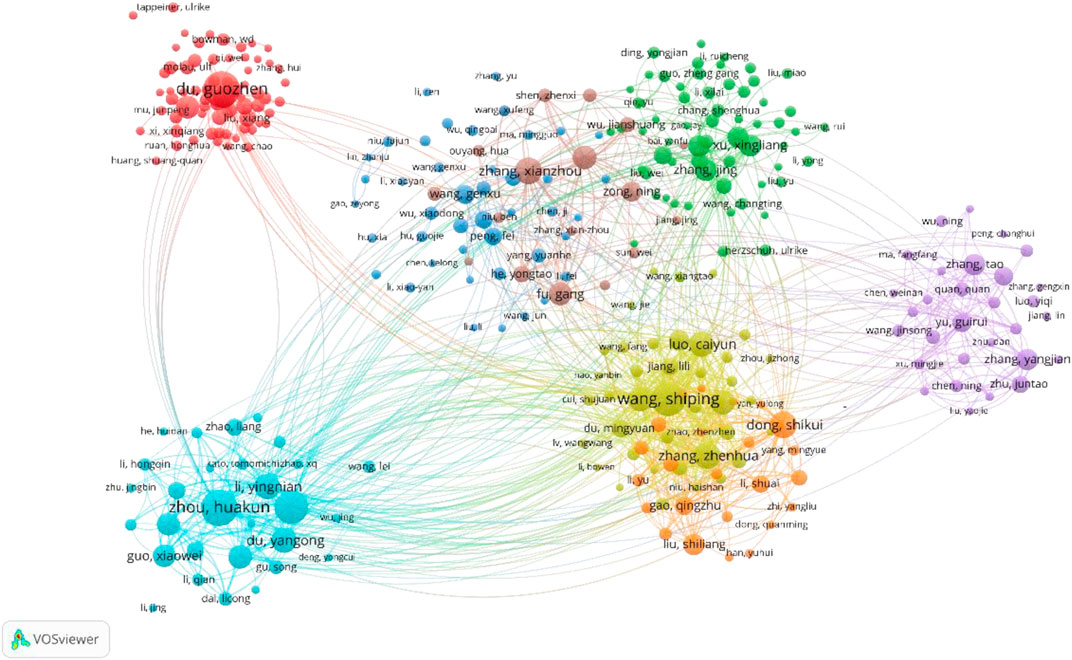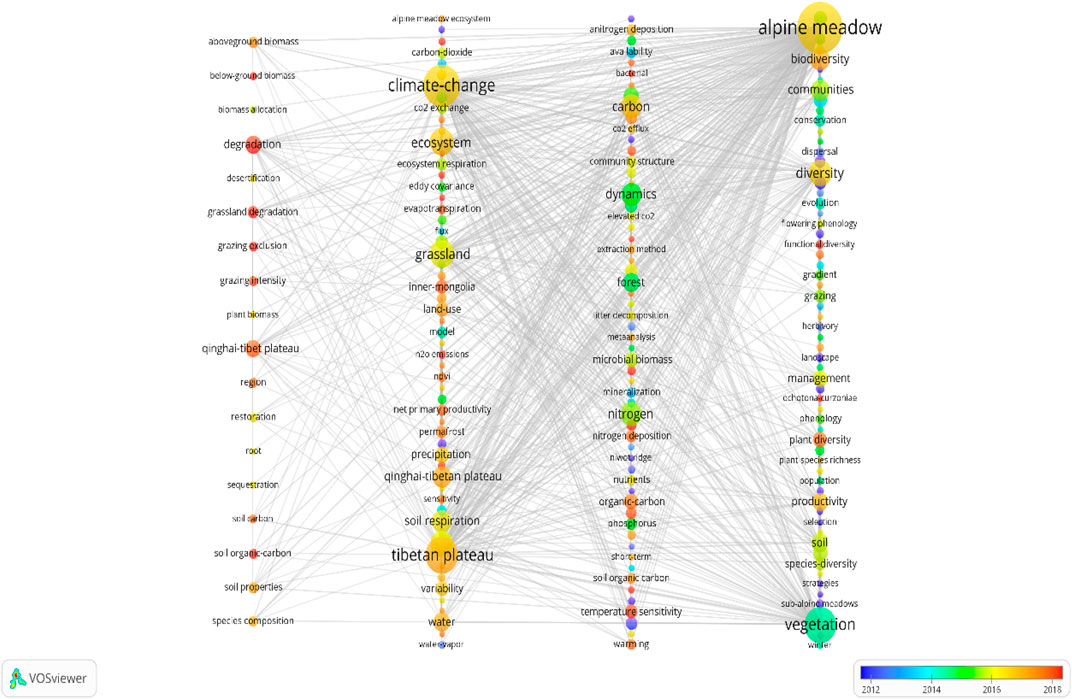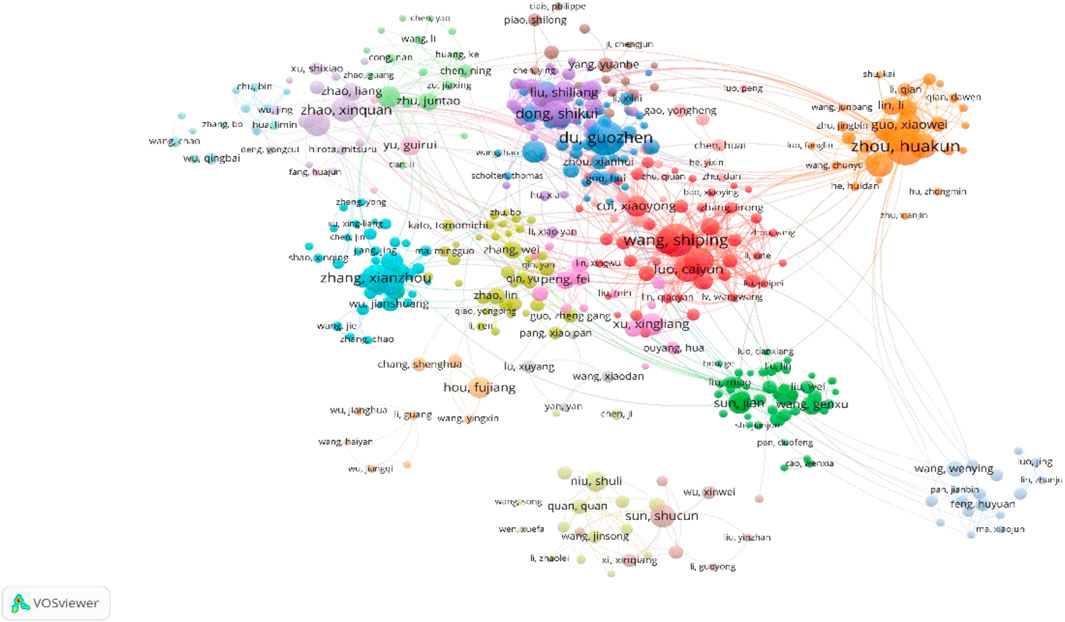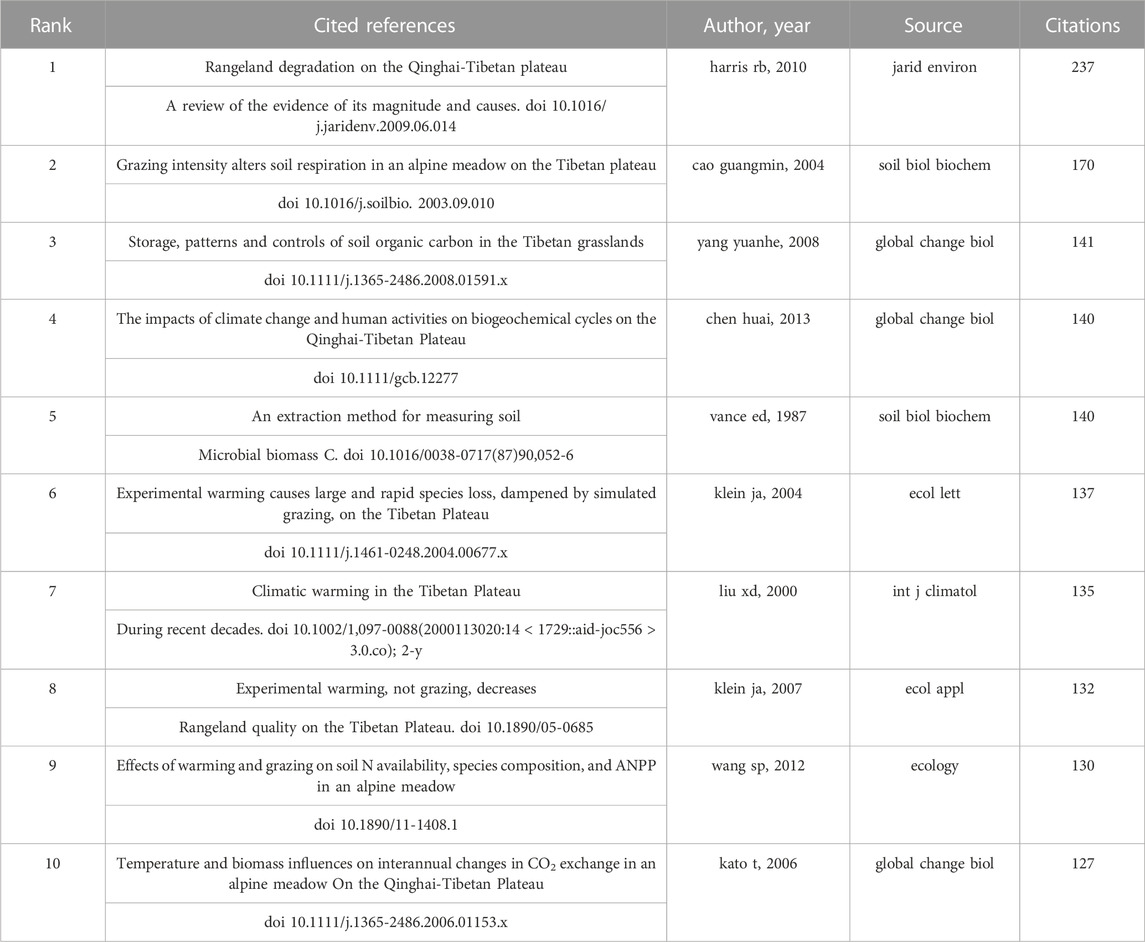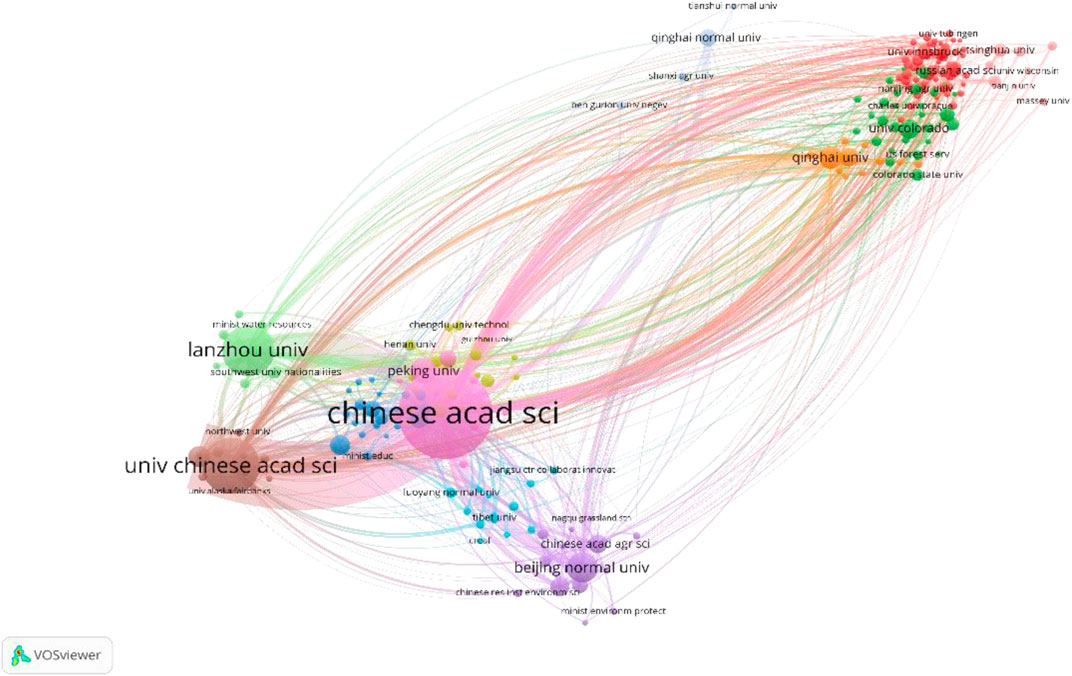- 1College of Agriculture and Animal Husbandry, Qinghai University, Xining, China
- 2Qinghai Institute of Animal Husbandry and Veterinary Medicine, Qinghai University, Xining, China
In order to reveal the overall research progress in the field of alpine meadows. In this study, a visual clustering analysis of the literature was conducted using VOS viewer software. The English literature related to alpine meadow was searched in the Web of Science database with publication dates limited to 2020–2021, and 3,607 papers were retrieved from the Web of Science using Excel software. By analyzing the basic profiles of annual publication volume, publication country/region, publication journal, publication institution, publication author, and keywords, the hot spots and development trends of alpine meadow research were derived. The data show that China is the top global country for alpine meadow research in the world, the institution with the most publications in Chinese Acad Sci, and the most publications are by Huakun Zhou from China (81 articles); “enzymes”, “climate change” and “microorganisms” are the current hot spots for alpine meadow research. This study analyzes the publication situation, research hotspots and research trends in the field of alpine meadow research to provide a reference for the academic research on alpine meadows for those related to this field.
1 Introduction
Alpine meadows are one of the most important components of terrestrial ecosystems (Wang et al., 2019). The unique “high” and “cold” natural environment of the Alpine meadows has resulted in extremely fragile alpine meadow ecosystems that are sensitive to local climate change and anthropogenic disturbances (Chen et al., 2018). Therefore, over the years, many scholars have focused on alpine meadows and conducted a lot of research on them. The research hotspots (subject terms) of alpine meadows have changed over time, showing an evolution from simple to complex and from macro to micro; all studies are centered on alpine meadows. For example, at the beginning of the research, the main focus was on vegetation biomass (Li, 1998; Li et al., 2003; Wang et al., 1995; Zhong et al., 1992) and vegetation community characteristics and soil physicochemical factors (Zhou et al., 2005; Zhang et al., 2014; Sun et al., 2016); as the research progresses, alpine meadows are more extensively studied. For example, grazing (Dong et al., 2002; Zhang et al., 2010; Zhang, 2014; Zhang et al., 2014; Li et al., 2019) soil microorganisms (Jiang et al., 2017; Zhao, 2019; Ma et al., 2020); degradation of alpine meadows (Wei and Li, 2012; Lin et al., 2013); permafrost (Yang et al., 2020; Ma et al., 2022); soil enzymes (Huang et al., 2019; Mi et al., 2021); and climate change (Luo, 2020; Luo et al., 2021). These studies on the subject of alpine meadows have focused on specific objects, using specific methods to analyze alpine meadows at spatial and temporal scales. Using bibliometrics to analyze national, institutional, and academic articles on alpine meadow research has not been published in the database, and it is not clear which country/institution is the main force in the field of alpine meadow research and what are the scientific results in the field of alpine meadow research. Therefore, it is necessary to review, summarize and analyze the relevant literature to clarify the research progress and trends and to provide a comprehensive reference for researchers in the field of alpine meadows.
Bibliometrics is a popular interdisciplinary scientific field that analyzes literature data through mathematical and statistical methods (Broadus, 1987). Bibliometric mapping focuses on the publication itself rather than the content contained in the publication (Catillon, 2019; Zhong et al., 2019). It analyzes and assesses the quality and interest of research and represents the current status and development of a specific field (Perrier et al., 2016; Luo et al., 2022). Up to now, bibliometrics has been widely used for specific research field analysis (Huang and Chang, 2011), co-citation analysis (Jiang et al., 2015), and analysis of the development of trends across the subject area (Zhong et al., 2019). In this study, we searched the literature on alpine meadows in Web of Science database since 2000, and used bibliometric analysis and cluster analysis to explore the research directions and hotspots of alpine meadows, aiming to help domestic and foreign scholars accurately grasp the current research status of the field and guide the further research directions of alpine meadows.
2 Materials and methods
2.1 Literature sources and search strategies
All articles published in the Web of Science database with the search subject words "(alpine meadow OR alpine meadows OR alpine-cold meadow OR high-cold meadow)" and “alpine meadow research”. The literature search period was set as “1 January 2000 to 31 December 2021". After we cleaned the data and removed duplicates, we obtained a total of 3,607 articles in the field of alpine meadow research. The citation data of these documents were obtained from the Web of Science collection, saved in “plain text” txt format, and then imported into the VOS viewer (Version 1.6.13) software.
2.2 Methods
VOS viewer software constructs and presents bibliometric maps of distance, size and density differences between nodes based on the co-citation and high-citation principles of the literature. It evaluates the research direction and hotspot of the literature by cluster viewing, overlay viewing and density viewing (Van Eck and Waltman, 2010). VOS viewer runs in Java environment and can import The VOS viewer runs in Java and can import literature in Web of Science format. By clicking “Create” in VOS viewer, the literature is imported into the software, and objects are selected and thresholds are set according to the analysis objectives (Gao et al., 2021). The distance between nodes indicates the closeness and similarity of the subject terms, and the node size represents the frequency of occurrence, and the higher density means the closer the connection and the stronger the relevance (Ling et al., 2020). In this study, the Type of analysis was selected as Co-occurrence, and the Unit of analysis was selected as Keywords, Authors, Organizations and Full counting. The frequency of co-occurrence of keywords is more than 25 times, which is a high frequency word and shows the research hotspots.
In order to make the clustering effect of the network mapping produced by VOS viewer more obvious, the results of VOS viewer were saved in Pajek format, named net., clu. and vec. files respectively. The saved files were then imported sequentially into Pajek software (Pajek software large complex network analysis tool is a powerful tool for studying various complex non-linear networks that exist today. pajek runs in a Windows environment and is used for analysis and visualization operations of large networks with thousands or even millions of nodes (De Nooy et al., 2018) that performs reordering clustering followed by importing into VOS viewer software. The co-cited national geographic visualization plots in the paper were produced by VOS viewer combined with Scimago Graphica software. Plots of the volume of articles issued by year were made by the software Origin Pro 2021.
2.3 Data analytics
The year, journal, author, institution, country/region, literature citation and keywords of alpine meadow related literature were analyzed using Microsoft Excel 2016 software, and the authors, institutions, country distribution and collaboration, literature co-citation and keywords were systematically analyzed and visualized using VOS viewer software for bibliometric analysis. The authors, institutions, country distribution and collaboration, literature co-citation and keywords were systematically analyzed and visualized using VOS viewer software (Li and Liu, 2020). Considering the rigor and accuracy of the study, the literature search statistics were searched independently by one researcher and proofread by one researcher.
3 Results
3.1 Year of publication, number of literatures
The year of publication of the 3,607 papers counted shows that the overall number of papers in the field of alpine meadows is on the rise, especially in the last decade with more increments, and the maximum number of papers published in 2021 is 383 (Figure 1). The overall trend of linear growth of the paper issuing articles was demonstrated by linear regression using origin Pro 2021, and the equation was obtained as y = 15.958x-31941 with R2 = 0.8779, indicating into an extremely significant linear relationship. After 2000, alpine meadow research entered the exponential growth stage, that is, alpine meadow research has a mature theoretical foundation and enters the stage of theoretical application.
3.2 Distribution of the most published countries/regions
Analyzing Figure 2, we found that the countries with high publication volume are China, United States, Germany, Japan, France, Australia, and Canada. These countries not only have strong research strength, but also have extensive research cooperation networks, and most of the alpine meadow research results come from these countries. China is the top country in the field of alpine meadow research, far ahead of other countries, because China has the “Qinghai-Tibet Plateau”, which is known as the third pole of the world, and alpine meadows account for 47% of the Qinghai-Tibet Plateau, which facilitates Chinese scholars to conduct research; it also reflects the importance of China in the field of alpine meadow research sideways.

FIGURE 2. Top 20 countries/regions with the largest number of research publications on alpine meadows.
The inter-country cooperation in alpine meadow research was analyzed using VOS viewer software, and the thicker the connecting line, the greater the number of country cooperation. The results show that China has established international cooperation with many countries, and the closest cooperation is with the United States, followed by New Zealand, Japan, and Australia. The results show that countries such as Sweden and Finland have researched in the field of alpine meadows before 2012, countries such as Norway, India, Canada, and Italy acted to research alpine meadows in 2014, and countries such as People r China, New Zealand, and Mongolia researched alpine meadows mainly after 2016 (Figure 3). The density analysis can be found that China and United States have more concentrated research in the field of alpine meadows (Figure 4).

FIGURE 3. Analysis of the cooperation network among various countries/regions in the field of alpine meadow research.
3.3 Analysis of paper authors, institutional distribution and cooperation network
The top three authors with the largest number of publications were Zhou, Huakun (81), Du, Guozhen (80) and Wang, Shiping (74) (Table 1), all from China. Meanwhile, the top 15 authors in the field of alpine meadows were all from China according to the study authorship collaboration. The map shows that in the field of alpine meadows, several collaborative sub-networks have been formed with the above authors as the core, and there are strong academic ties among scholars within the sub-networks, but there are collaborative relationships of varying strengths outside the sub-networks. This indicates that Chinese scholars in the field of alpine meadow research have strong ties within their respective teams, and that cooperation between individual teams needs to be strengthened.
The VOS viewer was used to map the co-occurrence of authors to.the trend of close cooperation within teams and lack of cooperation among teams in the field of alpine meadow research, as shown in the study results, is to some extent detrimental to the development of the field (Figure 5), and only through mutual communication and joint learning can we achieve breakthrough results in the field of alpine meadow research in Qinghai-Tibet. Therefore, there is a need to strengthen the cooperation and connection between various teams and scholars in China.
The number of published papers by research institutions can represent the research capability of their fields. 2,158 research institutions were listed in 3,607 papers, and the minimum number of 10 papers per institution was set, and 140 institutions were qualified. Chinese Acad Sci ranked first with 1,514 papers, followed by Chinese univ Chinese Acad Sci (575 papers) and Lanzhou university (549 papers) (Table 2).
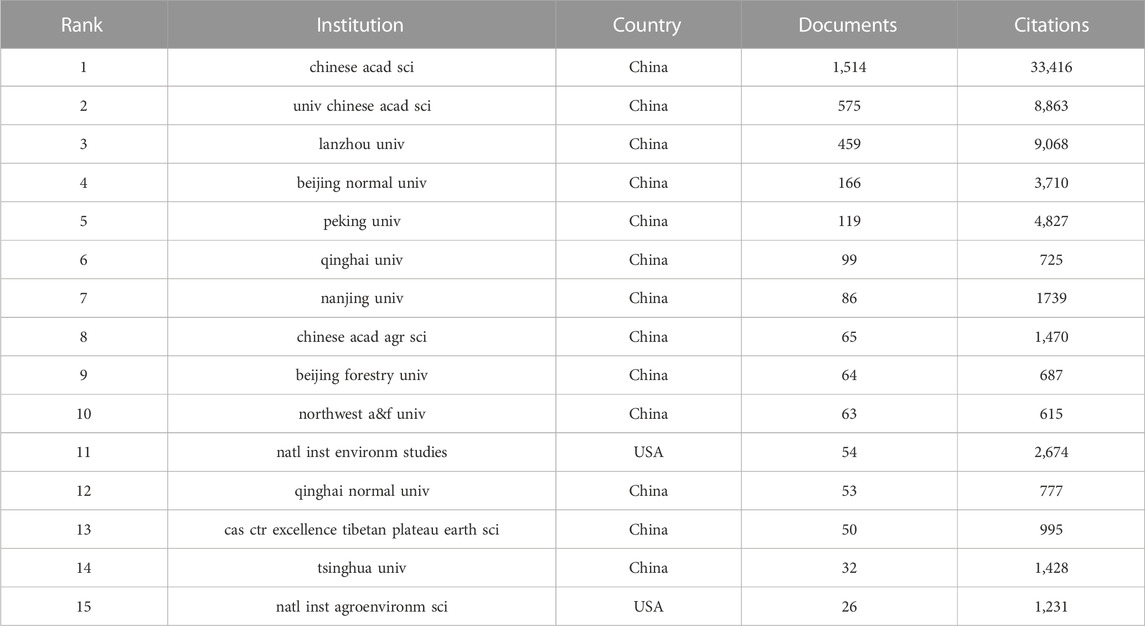
TABLE 2. Top 15 ranking of scientific institutions in the field of alpine meadow research in terms of number of publications.
The analysis of institutional cooperation network mapping showed that there were more local cooperation among research institutions, but less cross-regional cooperation, for example, there was very little cooperation between Qinghai Normal University and various research institutions, and mainly with Chinese Acad Sci and Lanzhou Univ (Figure 6). By superimposing the time of publication on the co-occurrence network of research institutions to obtain the time superimposition of institutions, i.e., different colors correspond to the average year of appearance of institutions in the literature, we can find the evolutionary trend of research institutions in alpine meadows, and Chinese Acad Sci, Qinghai Univ and Beijing Forestry Univ are the main research hotspots in alpine meadows (Figure 7). The trend of evolution of research institutions in alpine meadows can be found.
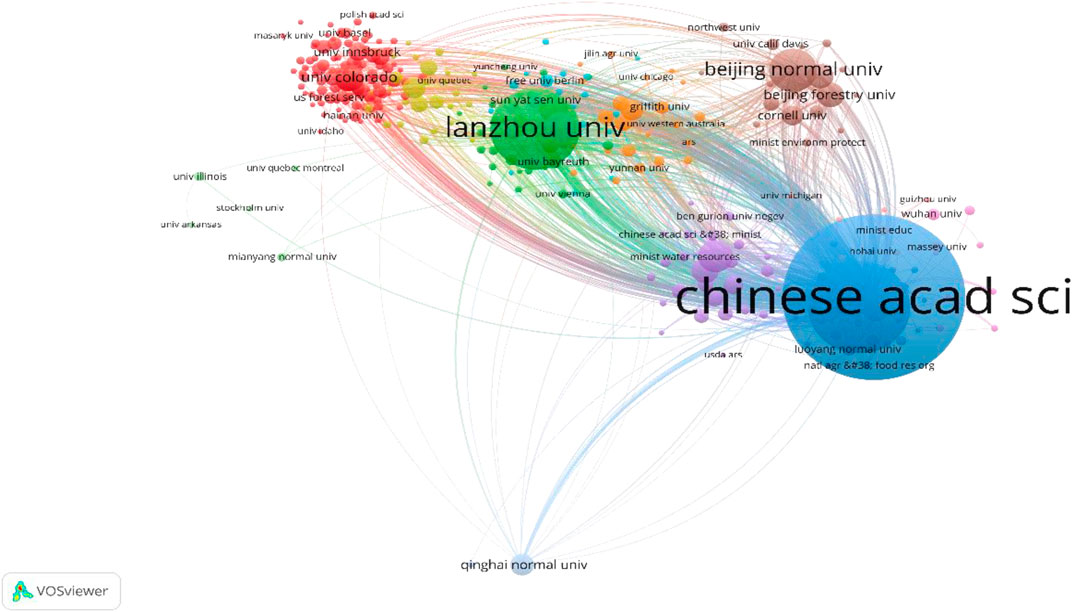
FIGURE 6. Mapping analysis of institutional cooperation network in the field of alpine meadow research.
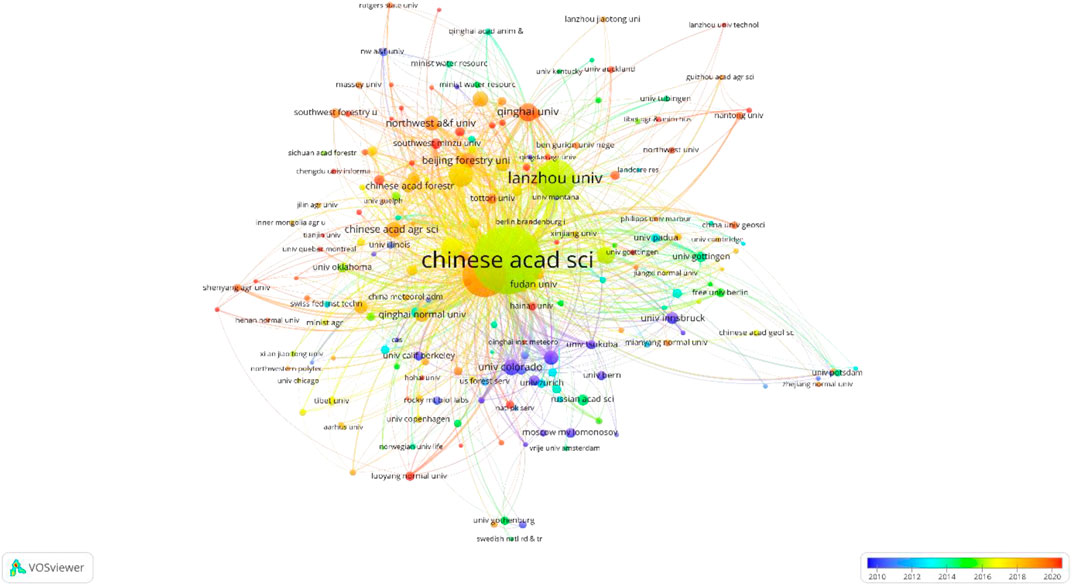
FIGURE 7. Clustering analysis of the temporal overlay mapping of papers published by institutions in the field of alpine meadow research.
3.4 Research keyword clustering and hot topic analysis
A total of 12,919 keywords were obtained in 3,607 documents. The accuracy and frequency of keywords are two important factors that affect the accuracy of the results of the co-occurrence method to identify research hotspots in the field (Pan et al., 2018). In order to make the analysis results more accurate, the keywords in the literature were first cleaned and collated, which mainly included the unification of the case and singular and plural of words, full names and abbreviations and synonyms. The cleaned keywords were counted by VOS viewer, and the keywords with frequencies >25 times were set as high-frequency keywords, and the keywords with the highest frequencies but no analysis significance, such as “response” and “impact”, were eliminated. The keyword co-occurrence network mapping, including clustering map, time superposition map, etc., was drawn.
According to the keyword co-occurrence network analysis, the current directional atmosphere of the alpine meadow research field can be divided into five major categories, which are red area, diversity direction; green area, research direction of microorganisms and nutrients such as carbon, nitrogen and phosphorus; blue area, research direction of climate change and soil respiration; purple area, research direction related to gases such as CO2 and CH4; yellow area, research direction related to grazing and grassland degradation (Figure 8). The time of publication was superimposed on the keyword co-occurrence network to obtain the keyword time superimposed map (Figure 9), i.e., different colors correspond to the average year of keyword appearance in the literature, and the research evolution trend of the field can be found. sensitivity, soil respiration, nitrogen deposition, N2O emissions, fungi, bacteria, etc. are the latest research hotspots in alpine meadows.
3.5 Analysis of authors of co-cited papers, institutional distribution and national cooperation networks
Smith. (2007) and Ugolini et al. (2015) showed that the number of co-citations indicates the influence, visibility and quality of a publication; however, Walter et al. (2003) noted that the number of citations by others does not indicate the quality of a publication, but rather measures its visibility. Therefore, co-citations of papers can identify scholars and institutions that have made significant contributions to the field or have struggled in the field for a long time, etc.
Analysis of Figure 10 shows that more than ten authors and their teams have certain popularity and influence in the field of alpine meadow research, and there are close collaborations among scholars within their teams; however, there are fewer collaborations among the teams. For example, Huakun Zhou’s team cooperates closely with Xinquan Zhao’s team, Wenying Wang’s team, Shiping Wang’s team, and Fujiang Hou’s team; and rarely with Xianzhou Zhang’s team and Guozhen Du’s team. The former teams are all located in northwestern China, on the one hand, because they are near the Qinghai-Tibetan Plateau, which facilitates cooperation among teams; on the other hand, it shows the lack of interaction between Chinese scholars and the need to strengthen cooperation and contact.
Table 3 shows the top ten co-cited articles in the field of alpine meadows, all with more than 120 co-citations, with the top article published in 2009 with 237 co-citations, followed by 170, and 141 co-citations. The most recent article was published in 2012 by Shiping Wang in ecology on the effects of warming and grazing on alpine meadow soils, with 130 citations. Nowadays, with the global climate change and the presence of herders on the Tibetan plateau, grazing and alpine meadows are inextricably linked, so this article is very informative in the study of alpine meadows.
As can be seen from Figure 11, Chinese Acad Sci is the main institution in terms of co-cited articles and far exceeds other institutions in terms of co-cited articles published. univ Chinese Acad Sci, Lanzhou Univ, and Beijing Normal Univ rank second, third, and fourth, respectively. Qinghai Univ (orange part in the figure) also contributes in the contribution of many Universities (institutions) such as Qinghai normal univ in the field of alpine meadow research cannot be ignored. It also shows that China’s research in the field of alpine meadow research far exceeds that of other international countries.
There are 15 countries with >48 articles among the 80 countries in the co-cited papers. Analysis of the geographical visualization map of co-cited countries (Figure 12) shows that the clustering results in three categories, the first category is dominated by Austria (the blue area), including Germany, the United Kingdom, and Italy, etc.; the second category is composed of countries such as China, the US, Japan and Australia (the purple area), and the third category is Canada (the red area). The thickness of the lines in the graph represents the intensity of cooperation, and it can be seen that the first-ranked China and the second-ranked United States cooperate closely, while other countries have cooperation relationships of varying intensity with each other.

FIGURE 12. Geographical visualization analysis of inter-country cooperation relations of co-cited papers.
4 Discussion
Bibliometric analysis is an effective method to identify the spatial and temporal distribution, knowledge structure and evolution of literature (Kou et al., 2021). In this research, the global alpine meadow-related research literature in the Web of science database was analyzed with the help of bibliometric visual analysis software VOS viewer and quantified in the form of visual networks and presented in the form of co-occurrence maps, including the visualization map of literature publishing author groups, the knowledge map of publishing institutions and the co-occurrence map of hot keyword clusters of literature. The results of the study found that China is the first country in the field of alpine meadow research (Figures 2–4, 12). There is little mutual cooperation between research author groups and groups, and the first authors of the published literature are all domestic authors and have collaborative relationships with a few foreign researchers. This study suggests that future researchers should strengthen mutual cooperation, and more importantly, strengthen cooperation with foreign researchers to achieve a higher level of research in line with international standards. The use of bibliometric analysis methods to quantify specific research fields or journals has become more common and gradually developed into a trend (Feng et al., 2022; Li et al., 2022; Wu and Li, 2022). Many disciplines such as medicine (Lin and Zhang, 2020), agronomy (Meng et al., 2023), ecology (Hu et al., 2023), soil science (Jiang and Peng, 2021), psychology (Liu and Gan, 2022), sociology (Li et al., 2015), pedagogy (Xu and Guo, 2011), environmental science (Wang et al., 2023) and physical education (Liu, 2022) have used the method of bibliometrics to comprehensively analyze the literature changes in their respective fields. Also, Zhao et al. (2023) showed that the combination of ecology, physiology, grass science, soil science, geography, biochemistry, mathematics and meteorology with effective cooperation at home and abroad has obvious positive effects on the study of alpine meadows. Li et al., 2022 mentioned in her paper on architecture research that future studies should combine management, politics, mathematics and other majors.
High-frequency keywords refer to keywords with high co-occurrence frequency, and a keyword that appears in high frequency within a certain period may be a research hotspot or research focus in a certain field at that time (Xu, 2012), and the resulting high-frequency keywords can reveal the thematic structure and hot issues of a research field through co-occurrence analysis by visual analysis software, which is more conducive to comprehensive analysis of research hotspots in a certain field (An and Zhang, 2014; Zhang, 2016). The results of high-frequency keyword analysis in this study showed that the hotspots of alpine meadow research were “enzymes”, “microorganisms”, “soil respiration”, and “climate change”. This indicates that there is a wealth of theoretical knowledge and scientific experiments on alpine meadows, and microscopic research is the main focus of alpine meadows research today. At the same time, the combination of geoinformation technology, remote sensing, meteorology and other disciplines to study alpine meadows may lead to extraordinary results, which are important for global grassland ecosystems and even global ecosystems.
Since this study is the first visual analysis of the relevant literature in the field of global alpine meadow research, there are some limitations in this study. First of all, a single Web of Science database search may omit articles related to the alpine meadow research, and some additional non-English literature may not be included in the analysis, which may contain important research results for this study. Secondly, low-frequency words were not analyzed in this study. According to Zipf’s law, some low-frequency terms cannot be excluded as potential research hotspots in the future (Aitchison et al., 2016). For example, “strategy” is a low-frequency word, but it is likely to become the next alpine meadow acting according to the field of theme words, the sustainable development of alpine meadow is closely related to the national and global people’s lives. This is similar to the findings of Romanian scholars on the Eurasian steppe (Nita et al., 2019). Third, the search strategy relied on relevant search terms being included in the title or appearing as keywords; therefore, some well-known classic articles may have been excluded (Calatrava Moreno et al., 2016). Fourth, the results for the most cited articles were biased because the earliest articles were cited more often than the most recent ones, which may have influenced the results of this study. Finally, the study of alpine meadows also needs to consider the politics, economy and culture, and the closeness of cooperation between researchers in each country, the ecological conservation policies between developing and developed countries, the laws introduced, and the ecological conservation awareness of local people (Nita, 2019; Nita et al., 2019; Manolache et al., 2020). These are all questions that need to be explored for future research.
5 Conclusion
In summary, this study clustered the research trends and hotspots in the field of alpine meadows using VOS viewer software to further visualize the latest research results in the field of alpine meadows. The results indicate that Chinese scholars are the main force in alpine meadow research, but regional and international multicenter research projects need to be actively pursued, especially the cooperation among domestic teams should be strengthened.” Key words such as enzymes, microorganisms, soil respiration and climate change are the focus of alpine meadow research. Research on alpine meadows also needs to consider the global distribution of alpine meadows, grassland conservation policies between developing and developed countries, and cooperative relationships between scholars from various countries. Reasonable ecological conservation policies, reasonable personnel management and appropriate personnel utilization will be of great benefit to the sustainable development of alpine meadows, the stability of grassland ecosystems and even the global conservation of grasslands.
Author contributions
WL conducted experiments, analyzed data, made tables and pictures, wrote a draft of the paper and approved the final draft. KD conceived and designed experiments, reviewed drafts of papers, and approved final drafts. XW, WW, and LZ supervised the writing of the paper and approved the final draft. XX and FL reviewed the draft paper and approved the final draft.
Funding
This study was funded by the National Natural Science Foundation of China (31860678) and the National Field Scientific Observation and Research Station of Qinghai Sanjiangyuan Grassland Ecosystem.
Acknowledgments
We are grateful to all the authors who contributed to this study, as well as the editor-in-chief of Frontiers in environmental science and each of the staff members who worked so hard to make this article of higher quality, and hope that it will be published in this journal.
Conflict of interest
The authors declare that the research was conducted in the absence of any commercial or financial relationships that could be construed as a potential conflict of interest.
Publisher’s note
All claims expressed in this article are solely those of the authors and do not necessarily represent those of their affiliated organizations, or those of the publisher, the editors and the reviewers. Any product that may be evaluated in this article, or claim that may be made by its manufacturer, is not guaranteed or endorsed by the publisher.
References
Aitchison, L., Corradi, N., and Latham, P. E. (2016). Zipf’s law arises naturally when there are underlying, unobserved variables. PLoS Comput. Biol. 12 (12), e1005110. doi:10.1371/journal.pcbi.1005110
An, Y., and Zhang, L. (2014). A review of research progress in the application of bibliometrics in China's library and intelligence field. Library 5, 63–68. Avaliable At: http://www.cqvip.com/qk/93140x/201405/662674277.html.
Broadus, R. N. (1987). Toward a definition of “bibliometrics”. Scientometrics 12 (5), 373–379. doi:10.1007/bf02016680
Calatrava Moreno, M. D. C., Auzinger, T., and Werthner, H. (2016). On the uncertainty of interdisciplinarity measurements due to incomplete bibliographic data. Scientometrics 107, 213–232. doi:10.1007/s11192-016-1842-4
Catillon, M. (2019). Trends and predictors of biomedical research quality, 1990–2015: A meta-research study. BMJ open 9 (9), e030342. doi:10.1136/bmjopen-2019-0303421136/bmjopen-2019-030342
Chen, N., Zhang, Y. J., and Zhu, J. T. (2018). Nonlinear responses of productivity and diversity of alpine meadow communities to degradation. Chin. J. Plant Ecol. 42 (1), 50–65. doi:10.17521/cjpe.2017.0252
De Nooy, W., Mrvar, A., and Batagelj, V. (2018). Exploratory social network analysis with Pajek:Revised and expanded edition for updated software. Cambridge: Cambridge University Press. doi:10.1017/9781108565691
Dong, Q. M., Li, Q. Y., and Shi, J. J. (2002). Effects of grazing intensity on above-ground biomass and yak growth in alpine meadows. Qinghai J. Animal Husb. Veterinary Med. 03, 5–7.
Feng, L., Feng, L., Shang, S., Feng, X., Kong, Y., and Bai, J. (2022). Evolution and trend analysis of research hotspots in the field of pollution-intensive industry transfer-based on literature quantitative empirical study of China as world factory. Front. Environ. Sci. 10, 732734. doi:10.3389/fenvs.2022.732734
Gao, Y. W., Yue, L. H., and Jiang, S. G. (2021). Analysis of the progress of safety evacuation research based on VOS viewer from 2010 to 2020. Saf. Environ. Eng. 28 (2), 1–13. doi:10.13578/j.cnki.issn.1671-1556.2021.02.001
Hu, Z. Y., Li, Z. X., Peng, L. H., and Yang, L. Z. (2023). Advances in bibliometric-based pro-biotic design research. J. Ecol. 1, 462–473. doi:10.5846/stxb202112193596
Huang, H. L., Zong, N., He, N. P., and Tian, J. (2019). Characterization of soil enzyme stoichiometry at different elevations in alpine meadows on the Qinghai-Tibet Plateau. J. Appl. Ecol. 30 (11), 3689–3696. doi:10.13287/j.1001-9332.201911.013
Huang, M. H., and Chang, Y. W. (2011). A study of interdisciplinarity in information science: Using direct citation and co-authorship analysis. J. Inf. Sci. 37 (4), 369–378. doi:10.1177/0165551511407141
Jiang, L. C., Wang, Z. Z., Peng, T. Q., and Zhu, J. J. (2015). The divided communities of shared concerns: Mapping the intellectual structure of e-Health research in social science journals. Int. J. Med. Inf. 84 (1), 24–35. doi:10.1016/j.ijmedinf.2014.09.003
Jiang, Y. M., Shi, S. L., and Tian, Y. L. (2017). Characteristics of changes in soil microbial and soil enzyme activities under different degradation levels in alpine grasslands. J. Soil Water Conservation 31 (03), 244–249. doi:10.13870/j.cnki.stbcxb.2017.03.041
Jiang, Z. Q., and Peng, H. (2021). Progress of soil nitrogen mineralization research based on bibliometric analysis. Soil Bull. 4, 975–987. doi:10.19336/j.cnki.trtb.2020102101
Kou, W. J., Wang, X. Q., Li, Y., Ren, X. H., Sun, J. R., Lei, S. Y., et al. (2021). Research trends of posttraumatic growth from 1996 to 2020: A bibliometric analysis based on Web of science and cite space. J. Affect. Disord. Rep. 3, 100052. doi:10.1016/j.jadr.2020.100052
Li, H. Q., Zhang, F. W., Mao, S. J., Zhu, J. B., He, H. D., Wei, Y. X., et al. (2019). Effect of grazing intensity on carbon exchange in alpine dwarf tarragon meadow in Haibei, Qinghai. Chin. J. Grassl. 02, 16–21. doi:10.16742/j.zgcdxb.20170249
Li, J., Huang, Z., and Su, J. (2015). Reshaping policy text data analysis with bibliometric research - origins, migration and methodological innovation of policy bibliometrics. J. Public Adm. 12 (02), 138–144. doi:10.16149/j.cnki.23-1523.2015.02.013
Li, J., and Liu, J. (2020). Science mapping of tunnel fires: A scientometric analysis-based study. Fire Technol. 56, 2111–2135. doi:10.1007/s10694-020-00969-z
Li, R. Y. M., Li, B., Zhu, X., Zhao, J., Pu, R., and Song, L. (2022). Modularity clustering of economic development and ESG attributes in prefabricated building research. Front. Environ. Sci. 10, 977887. doi:10.3389/fenvs.2022.977887
Li, Y. N., Zhao, X. Q., and Wang, Q. X. (2003). Comparison of biomass and environmental conditions of five vegetation species in alpine meadows of Haibei, Qingha. J. Mt. Sci. 03, 257–264. Avaliable At: http://ir.nwipb.ac.cn/handle/363003/706.
Li, Y. N. (1998). Some characteristics of above–ground biomass growth processes of alpine meadow plants[J]. Chinese Agric. Meteorol. 06, 46–49+56. Avaliable At: http://www.cqvip.com/ qk/ 92555X/199801/ 2897194.html.
Lin, L., Wu, Y. N., Tamura., K., Huo, G. W., Luo, W. T., and Lu, J. Z. (2013). Physicochemical and microbial properties of typical degraded grassland soils in Hulunbuir. J. Appl. Ecol. 24 (12), 3407–3414. doi:10.13287/j.1001-9332.2013.0573
Lin, X., and Zhang, H. Bo. (2020). A review of international public health emergency research: A bibliometric-based analysis. Risk Disaster Crisis Res. 2, 29–49.
Ling, J., Fan, Y. Q., and Hu, L. W. (2020). Visualization analysis of hotspots of research on SARS-CoV-2 based on Cite Space and VOS viewer. Chin. J. Nosocomiol 30 (8), 1468–1474. doi:10.1816/cn.ni.2020-206052
Liu, L. (2022). A review of China's elderly sports research based on bibliometrics. Sichuan Sports Sci. 6, 101–107. doi:10.13932/j.cnki.sctykx.2022.06.20
Liu, S., and Gan, Y. T. (2022). Hot spots and future trends of hyperscanning research: A bibliometric-based analysis. Chin. J. Appl. Psychol. 28 (02), 180–192.
Luo, D., Liang, W., Ma, B., and Xue, D. (2022). Global trends of indocyanine green fluorescence navigation in laparoscopic cholecystectomy: Bibliometrics and knowledge atlas analysis. Surg. Endosc. 36 (9), 6419–6431. doi:10.1007/s00464-021-08988-9
Luo, J., Wang, J. B., and Yang, Y. S. (2021). Climate attribution study of dry and wet conditions and forage yield changes in Hequ alpine meadows of Three River Source from 1991-2015. Glacial Permafr. 43 (05), 1542–1550. Avaliable At: http://ir.igsnrr.ac.cn/handle/311030/183582.
Luo, W. R. (2020). Simulation and prediction of climate change impacts on net CO_2 exchange in alpine meadows of northern Tibet. Chin. Acad. Agric. Sci., 1–5. doi:10.27630/d.cnki.gznky.2020.000559
Ma, J. J., Wang, P., and Deng, Y. J. (2022). Characteristics of seasonal permafrost soil temperature and humidity changes in alpine meadows of Qinghai Lake basin. Soil 54 (03), 619–628. doi:10.13758/j.cnki.tr.2022.03.024
Ma, Y., Yang, J., and Zhang, D. G. (2020). Effects of alpine meadow degradation on soil microbial biomass and nitrogen mineralization rate in Qilian Mountains. J. Ecol. 40 (08), 2680–2690. doi:10.5846/stxb201902010231
Manolache, S., Nita, A., Hartel, T., Miu, I. V., Ciocanea, C. M., and Rozylowicz, L. (2020). Governance networks around grasslands with contrasting management history. J. Environ. Manag. 273, 111152. doi:10.1016/j.jenvman.2020.111152
Meng, F. P., He, X. H., Luo, C., and Wei, C. L. (2023). Analysis of world mango research trends based on bibliometrics and VOS viewer. China Fruit. Tree 1, 83–88. doi:10.16626/j.cnki.issn1000-8047.2023.01.015
Mi, Q., Wang, Y., and Qin, X. J. (2021). Soil enzyme stoichiometry characteristics of alpine meadows on the Qinghai-Tibet Plateau at different fencing years. J. Grassl. 29 (01), 33–41. doi:10.11733/j.issn.1007-0435.2021.01.005
Nita, A. (2019). Empowering impact assessments knowledge and international research collaboration-A bibliometric analysis of Environmental Impact Assessment Review journal. Environ. Impact Assess. Rev. 78, 106283. doi:10.1016/j.eiar.2019.106283
Nita, A., Hartel, T., Manolache, S., Ciocanea, C. M., Miu, I. V., and Rozylowicz, L. (2019). Who is researching biodiversity hotspots in eastern europe? A case study on the grasslands in Romania. PLoS ONE 14 (5), e0217638. doi:10.1371/journal.pone.0217638
Pan, W., Zheng, P., and Huang, J. Q. (2018). Research hotspot detection of health information based on the “DEAN” process of data clean. Mod. Inf. 38 (10), 73–77. Avaliable At: http://www.cqvip.com/qk/95530a/201810/7000855475.html.
Perrier, L., Lightfoot, D., Kealey, M. R., Straus, S. E., and Tricco, A. C. (2016). Knowledge synthesis research: A bibliometric analysis. J. Clin. Epidemiol. 73, 50–57. doi:10.1016/j.jclinepi.2015.02.019
Smith, D. R. (2007). Historical development of the journal impact factor and its relevance for occupational health. Ind. Health 45 (6), 730–742. doi:10.2486/indhealth.45.730
Sun, L., Liu, Y., and Wu, G. l. (2016). Relationship between biomass and soil nutrients in degraded grassland communities in northern Tibet. Grassl. Sci. 06, 1062–1069. Avaliable At: https://www.cnki.com.cn/Article/CJFDTOTAL-CYKX201606007.htm.
Ugolini, D., Bonassi, S., Cristaudo, A., Leoncini, G., Ratto, G. B., and Neri, M. (2015). Temporal trend, geographic distribution, and publication quality in asbestos research. Environ. Sci. Pollut. Res. 22, 6957–6967. doi:10.1007/s11356-014-3925-1
Van Eck, N., and Waltman, L. (2010). Software survey: VOS viewer, a computer program for bibliometric mapping. Scientometrics 84 (2), 523–538. doi:10.1007/s11192-009-0146-3
Walter, G., Bloch, S., Hunt, G., and Fisher, K. (2003). Counting on citations: A flawed way to measure quality. Med. J. Aust. 178 (6), 280–281. doi:10.5694/j.1326-5377.2003.tb05196.x
Wang, Q. J., Zhou, X. M., and Zhang, Y. Q. (1995). Structural characteristics of alpine small tarragon steppe meadow plant community and its biomass. J. Plant Ecol. 19 (03), 225–235. Avaliable At: http://ir.nwipb.ac.cn/handle/363003/1149.
Wang, X., Zhang, M., Nazieh, S., and Nkrumah, T. (2023). Temporal and spatial distribution of the alpine meadow carbon budget in Gannan, China from 1969 to 2018. Front. Environ. Sci. 10, 922968. doi:10.3389/fenvs.2022.922968
Wang, Y. Q., Yin, Y. L., and Li, S. X. (2019). Analysis of physicochemical properties and enzyme activities of alpine meadow soils with different degrees of degradation. J. Ecol. Environ. 6, 1108–1116. doi:10.16258/j.cnki.1674-5906.2019.06.005
Wei, W. D., and Li, X. L. (2012). Analysis of soil characteristics of alpine grassland with different degradation degrees in Three River Source District. Hubei Agric. Sci. 51 (06), 1102–1106. doi:10.14088/j.cnki.issn0439-8114.2012.06.056
Wu, T., and Li, M. (2022). International research progress and trend of transit-oriented development: An analysis of knowledge mapping based on cite space. Front. Environ. Sci. 1251, 937340. doi:10.3389/fenvs.2022.937340
Xu, P. Y., and Guo, V. (2011). “A new species of the genus Phyllostachys (Hymenoptera, Braconidae) from China,” in Teacher competency research in China: Stages, themes, and frontiers - a cite space-based bibliometric analysis (Lanzhou: Lanzhou University), 61–67.
Xu, Z. W. (2012). Key words and subject terms in medical papers Clinical meta-analysis. Avaliable At: http://www.cqvip.com/qk/92326x/201220/43405589.html.
Yang, K., Wang, G. X., and Zhang, T. (2020). Functional traits of alpine meadow roots under different moisture conditions in response to temperature increase in the permafrost region of Qinghai-Tibet Plateau. J. Ecol. 40 (18), 6362–6373. doi:10.5846/stxb202001060042
Zhang, C. H. (2014). Effects of grazing practices and fertilization gradients on productivity and species richness in alpine meadow communities. Grassl. Sci. 31 (12), 2293–2300. Avaliable At: https://www.cnki.com.cn/Article/CJFDTOTAL-CYKX201412016.htm.
Zhang, F. W., Wang, J. B., and Lin, L. (2014). Response of vegetation community characteristics to degradation succession in alpine tussock meadows on the Qinghai-Tibet Plateau. China Agric. Meteorol. 35 (05), 504–510. Avaliable At: https://www.irgrid.ac.cn/handle/1471x/2437854.
Zhang, L. R., Niu, H. S., and Wang, S. P. (2010). Effects of warming and grazing on stomatal density and stomatal length of four species of dwarf tarragon meadows. J. Ecol. 30 (24), 6961–6969. Avaliable At: http://ir.nwipb.ac.cn//handle/363003/2972.
Zhang, X. T. (2016). Exploring the hot spots of national reading research based on social network analysis method. J. Agric. Libr. Inf. 8 (6), 80–84.
Zhao, X. Q., Cao, G. M., Xu, S. X., Zhou, H. K., Zhao, L., Li, Y. N., et al. (2023). Alpine meadow ecosystems and global change. Avaliable At: https://kns.cnki.net/KCMS/detail/detail.aspx?dbname=SNAD&filename=SNAD000001394096.
Zhao, Y. (2019). Response of soil microbial communities in alpine meadows on the Qinghai-Tibet Plateau to changes in temperature increase and rainfall. Lanzhou: Lanzhou University. Avaliable At: https://cdmd.cnki.com.cn/Article/CDMD-10730-1019874441.htm.
Zhong, B., Wu, H., Ding, L., Love, P. E., Li, H., Luo, H., et al. (2019). Mapping computer vision research in construction: Developments, knowledge gaps and implications for research. Automation Constr. 107, 102919. doi:10.1016/j.autcon.2019.102919
Zhong, H. M., Yang, F. H., and Lu, G. Q. (1992). Relationship between aboveground biomass and meteorological factors in alpine dwarf tarragon meadows. J. Ecol. 05, 16–19. Avaliable At: http://www.cje.net.cn/CN/abstract/abstract18503.shtml.
Zhou, H. K., Zhao, X. Q., and Zhou, L. (2005). Vegetation degradation and soil degradation characteristics of alpine meadows on the Qinghai-Tibet Plateau. J. Grass Industry 03, 31–40. Avaliable At: https://www.irgrid.ac.cn/handle/1471x/2499503.
Keywords: alpine meadow, modular cluster analysis, geographical visualization analysis, Qinghai-Tibet Plateau, bibliometric method
Citation: Lin W, De K, Wei X, Wang W, Zhang L, Xiang X and Li F (2023) Visual analysis of alpine meadow research trends and hotspots based on VOS viewer. Front. Environ. Sci. 11:1095299. doi: 10.3389/fenvs.2023.1095299
Received: 11 November 2022; Accepted: 27 March 2023;
Published: 12 April 2023.
Edited by:
Rui Zhao, Southwest Jiaotong University, ChinaReviewed by:
Andreea Nita, University of Bucharest, RomaniaXiaojun Yu, Gansu Agricultural University, China
Copyright © 2023 Lin, De, Wei, Wang, Zhang, Xiang and Li. This is an open-access article distributed under the terms of the Creative Commons Attribution License (CC BY). The use, distribution or reproduction in other forums is permitted, provided the original author(s) and the copyright owner(s) are credited and that the original publication in this journal is cited, in accordance with accepted academic practice. No use, distribution or reproduction is permitted which does not comply with these terms.
*Correspondence: Kejia De, MTE2MjE1Nzk0OEBxcS5jb20=
 Weishan Lin
Weishan Lin Kejia De1,2*
Kejia De1,2*